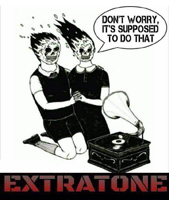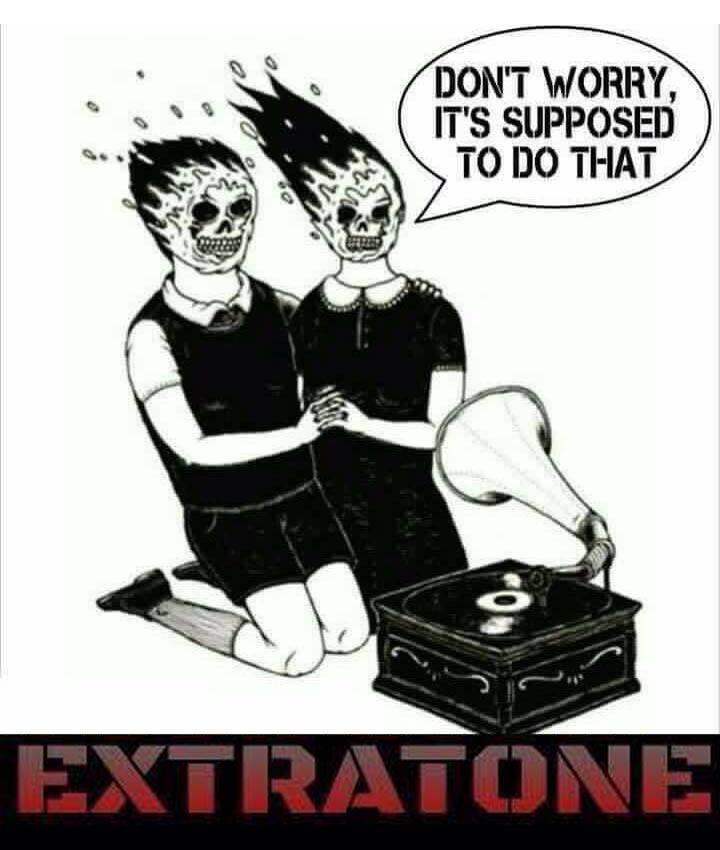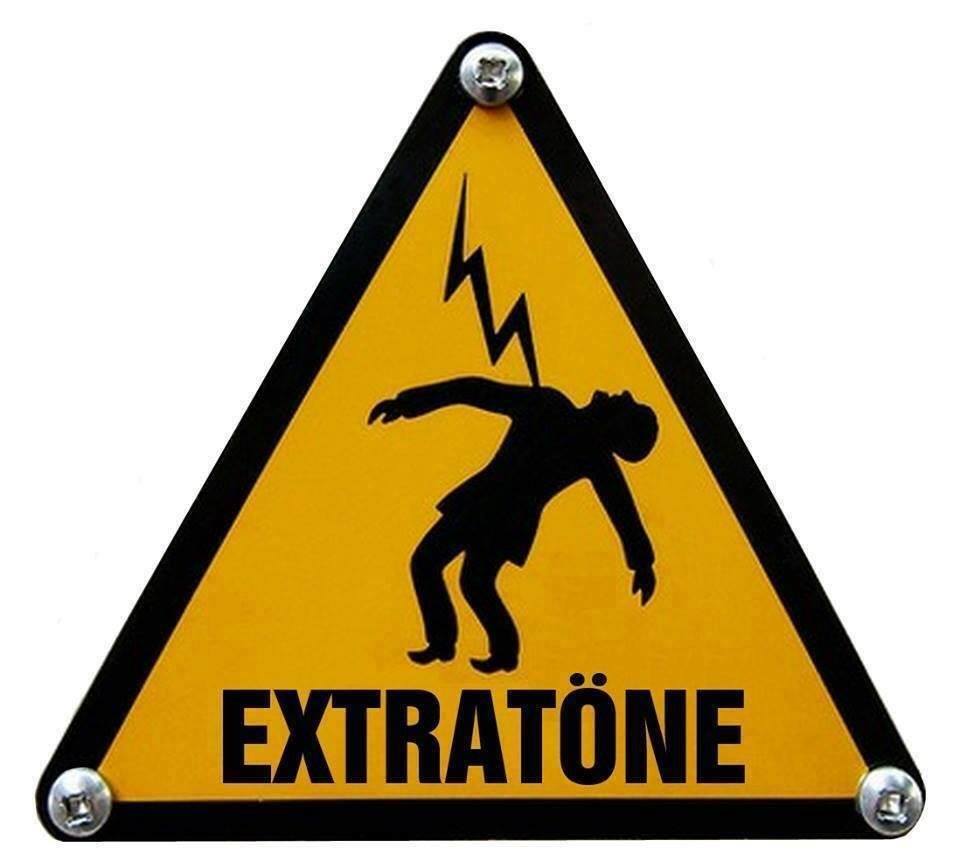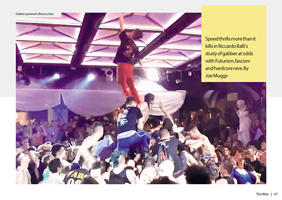
AGAINST EXTRATONE GENTRIFICATION!
by Sonic Belligeranza 24 Maggio 2018Dave Jenkins: Firstly, can you fill me in a little on your book? The concept seems brilliantly daft… (But the interview with Ralph is super informative!)
Dj Balli: “Frankenstein, or the 8 bit Prometheus” out for chilicomcarne.com is a book that celebrate the first 17 years of my label (2000-2017) and it does that with 17 texts exploring different angles of Sonic Belligeranza records interspersed in a mash-up of Mary Shelley’s classic. Why Frankenstein? Giovanni Aldini (1762-1834) hailing from shithole Bologna, Italy – just like me and my label! – apparently influenced with his macabre experiments of electric impulse on dead bodies Mary Shelley for the writing of her Modern Prometheus. Also known with his English name John Aldini, the nephew of scientist Luigi Galvani (Bologna, 1737-1798), tried to publicly revive corpses in crowded theaters all over Europe by aid of galvanic technologies. Similarly, from its inception on, Sonic Belligeranza administered – live and on digital or galvanic format – a variety of electroshock treaments to a multitude of audience everywhere. Extratone is one of this variety of treatments, consequently one the 17 above-mentioned texts in my book deals with this subgenre extensively through an interview with Sonic Belligeranza associate producer Ralph Brown.

Dave Jenkins: Obviously you as an individual and the label have celebrated, nurtured and encourage a wide range of extreme hardcore and experimental styles. Where does extratone fit into this collage for you?
Dj Balli: @Sonic Belligeranza records, I follow the motto “it has to be innovative”. For me being a producer and a label owner in the experimental hardcore scene, or however you want to call it, means to question myself about which could be the most subversive sound strategy. Either by giving a personal contribution to an existing fresh scene like the 8 bit-metal one, or conjuring up one like what I attempted with my skateboard-noise release, I try to push unheard sounds. My adhesion to extratone is connected to getting to know a local producer here in Bologna using the monicker Ralph Brown as homage to Italian Z-movier director Renato Polselli, who used that alias to release some films that sported weirder names than the movies themselves. Ralph got me into extratone and together we developed our own idea of this style in the release “Tweet it!” (S.B.10).
Dave Jenkins: I have to admit I’m new to extratone but find it fascinating. I don’t find the music easy to listen to, but it’s not meant to be an easy trip, right? Anything from Frenchcore upwards isn’t meant to be an easy trip, discuss….
Dj Balli: I see extratone as pure power/pure frequency that you clench in your fist provocatively defying any hardcore audience you can imagine. It’s so hard that, in a way ,it’s not hard anymore, just like it is so fast that in the end it’s not fast anymore. I like this self-destructive component of this style, when beats get so fast you can’t detect them anymore, you experience at the same time aggressivity and chill. Extratone is, to me, also a nerdy sound connected to the square wave of 8 bit music. Extratone itself in fact can be a square wave itself.
Dave Jenkins: At the same time, there’s also a lot of humour and tongue-in-cheek humour at play here, this isn’t to be taken entirely seriously at all times, right?
Dj Balli: Absolutely! At least this is the way I personally see this super-hyper-mega fast sound. That fist clenched in front of the audience I was mentioning is thought to be indeed very ironical, but also serious and ironical and so on in an endless game with the attendees and myself (intended as the extratone player). Again this self-denying element form this sub-sound, this is wicked (and boring) and wicked!!!
Dave Jenkins: So we learnt that extratone can be pinpointed to a Belgian DJ named Einrich in the late 90s, from your interview, so what are your memories of early extratone? How was it received by the extreme hardcore community?
Dj Balli: Before extratone got his name and status as a sub-style, we can acknowledge a variety of tracks reaching the peak of 1000 bpm: Moby’s tune “Thousand” (1993), “Human 1000 BPM De Rebel Va Te Faire Enculer Rubik” from “Trrr…” ep (1994) on Explore Toi French label/sound system and “Killer Machinery” from “Thundterdome 4 ep remix (1994) by dj Dano, Dj Gizmo, Buzz Fuzz & Prophet, to name only the tracks I remember. These tunes were hyperbolic acceleration reaching the “impossible” threshold of 1000 bpm, to be seen more as a sort of extravagant bonus track inside an ep than else. I can see them interpreted as moments of furious, extreme madness in a context, such us the hardcore one, that hails madness as its founding element.

Dave Jenkins: From what I’ve read and heard, extratone isn’t always accepted by speedcore fans and can be a little a divisive, what are your thoughts on this?
Dj Balli: Yeah, there are speedcore guys complaining extratone ain’t good to dance to or that is boring, but on the other hand, I’ve experienced speedcore parties in which last sets consisted of extratone acts. So, as you say, opinions disagree on the issue, but I’m positive I can count more pro extratone geezer in the hardcore community than against it.
Dave Jenkins: It may have taken root in the late 90s but when did extratone really begin to become a sound / ideology in its own right?
Dj Balli: Right at the end of the Zero Years, with dj Ninja Love Mistake (rip) and his label label 1000+ from Uk. I’d say that was the inception of extratone as a music scene. And focussing on the figure of Ian Garside (real name of the aforementioned) I wanna highlight his root as a producer in Game Boy music confirms my hypothesis of extratone deriving also from 8 bit not only as an extremization of speedcore.
Dave Jenkins: Is ideology too strong a word? There does seem to be a strong punk-like ethos behind it (and all extreme strains of hardcore)
Dj Balli: It is indeed too strong! In my opinion, stricly extratone community is too much limited in terms of number of people involved, this niche is, mostly, absorbed in the wider speedcore scene. Consequently its ideology can be, more generally, traced back to this latter music style subgenre.
Dave Jenkins: It seems very different from other extreme genres such as speedcore because, as you mentioned on email, it’s a tonal / textural and not sledgehammer kicks. This seems like a big shift and opens up a whole new realm of creativity in the extreme hardcore continuum, doesn’t it? Kinda closer to sound art and experimentalism, maybe?
Dj Balli: I agree working with tonal / textural audio opens a sort of algebraic and mathematical realm of sound which I found stimulating as a producer. However, I think this differ from, for example, sound art. Personally I think this latter it’s mostly self-celebrating and repeating cliches of a tradition, the avantgarde one. What is in the majority of the cases considered experimental music has got nothing truly experimental in it. Extratone could also be considered dronish if you want to pigeonhole it in a more academical genre, but with a dynamic afflatus. The noise constituting its texture ain’t static, on the contrary it’s thought to be, essentialy, dance, music. And this is what makes it interesting to my ears.
Dave Jenkins: I assumed there was a race to just get faster and faster and that splittercore was the stepping stone to extratone. But this doesn’t seem to be the case. Can things ever get too fast?
Dj Balli: In terms of bpm speed, Splittercore defines some step before extratone, it is indeed approximately 700/800 bpm, not more. Then as labelling term it arrived later than extratone, so as you correctly state there’s no lineage: splittercore > extratone. At the end of the day, as for mainstream music, also in the underground there’s this hysteria of conjuring up new terms to sell/impose new sounds, new scenes, new records. Not necessarily behind a fresh new music style term stands a cutting-edge sound for our ears.
Dave Jenkins: The most significant extratone release on Sonic Belligeranza would be your Tweet It release with Ralph. Could you tell me a little more about that? Passenger Of Shit actually recommended it to me as ‘the only decent extratone worth listening to’
Dj Balli: I was amazed by this coincidence of number of data produced per second by Audio and Twitter. In fact, Digital Sound (cd quality) consists of 44.100 Khz X 16 bit x 2 channels for a total of 1.411.200 bits (per second). Whereas, having compared most reliable statistics on the number of tweets per day it is reasonable to assume that Twitter produces and average of 2600 individual tweet per second. The estimated average length is 70 characters at 8 bit rate that is 2600 x 70 x 8= 1.456.000 bit per second (survey done in 2012 by Isaac Hepworth, product partnership @ Twitter). In short, Twitter in 2012 was producing about the same amount of data per second as digital audio cd. From this pseudoscientific similarity, the idea of producing a Twitter extratone ep with tracks lasting 1 minute and 40 seconds, intro and outro constituting of 0 minute and 14 seconds of twittering birds, 140(0) bpm for each track at 140 Herz, 140 characters for every tune text and so on. How does Twitter sound? Like Sonic Belligeranza 10!!!

Dave Jenkins: Speaking to one extratone producer, they explained that everyone can be a creator, how extratone fans get involved and add their own twists and that it’s a very open form of expression. Is this something you’ve experienced yourself?
Dj Balli: I’m not sure I agree on this. I don’t think it’s only about reaching the 1000 bpm +. I can see today many “producers” stepping on stage and playing ultra-fast, convinced this is the only thing it matters. I’d say it’s also about creating a structure, using stop and go, working on sound grain and so on.
Dave Jenkins: Who are the most exciting artists within the extratone realm in your opinion and why?
Dj Balli: Mr Q8, one of the first 1000+ artists, whereas between the newbie Gabberdoom from Holland. Both are from Speedcore Italia agency. Then you have the historical figure in the scene, Pyrrhon and Pirtek.
Dave Jenkins: What is an extratone live experience like and who are the best Djs/performers?
Dj Balli: 90% of extratone is played live on lap-top using ableton live. If you see, say, 3 acts of extratone produced this way, you’ll surely get bored. My crazy idea to render this more lively is to play extratone on vinyl using old school hip-hop technique. Basically, I beat juggle with two copies of the same vinyl “Tweet it!”, of course what I juggle around on turntables is not beat, but pure tone. So in the end I land in a hybrid, abstract turntablism no man’s land. Talking about more traditional extratone live act, I can’t not mention my colleague Ralph Brown. His act is totally intense,, 100% adrenalinic and he’s not using abletone live. When he plays he has these serial killer eyes fixed on the screen, a blast!! At the same time, scary and hilarious.
Dave Jenkins: Finally, a though about moetone and supertone. More sub-sub-subgenres. Do you think all these hardcore subgenres limit creativity or do they help to provide a framework for expression and code of references?
Dj Balli: You can get an exhaustive idea of moetone from this compilation on 1000+ entitled” Absolute Moetone Anthems Volume 1”. I’m not sure we can call this a sub-subgenre of its own, this is mostly extratone using samples from lolicon culture. Some peculiar sound solution can effectively follow the usage of certain samples from anime/manga, but still this is more a “thematic” sub-subgenre then else. Whereas supertone it’s about a range from 4000 to infinity bpm, going beyond the threshold of human earing. Somehow, this sub-substyle claims a level of scientificity, which, I’m afraid, nobody agreed to it. But it can be fun though.

Dave Jenkins: I’m interested in the technicalities of extratone. Are there things that can be achieved at ultra fast tempos that can’t be achieved in slower genres? (For instance, that physical warping feeling you get when the kicks move through the tonal range) You can reach a level of abstract terrorism only at the peak of textural extratone, approximately when the beat is beyond 3000 bpm and you have this whistle, pure tone I like to call it. What are the unique technical challenges facing a producer when working at 1000+ BPM?
Ralph Brown: To be honest, challenges are the same every music producer is facing. In my opinion, ultra-fast context doesn’t have any specific trick of its own.

Dave Jenkins: Coincidentally a producer contact of mine mentioned today on social media how he’s just heard extratone for the first time and remarked the fast tempos create additional harmonic tones. Can you explain that a little more? I’m sorry I’m not massively technical in this way!
Ralph Brown: It’s a matter of layerings, used by some producers into more melodic form of extratone. You can play a lot with layerings using them in a rhythmical way, personally I’m more inclined to use samples than creating harmonic tones.




